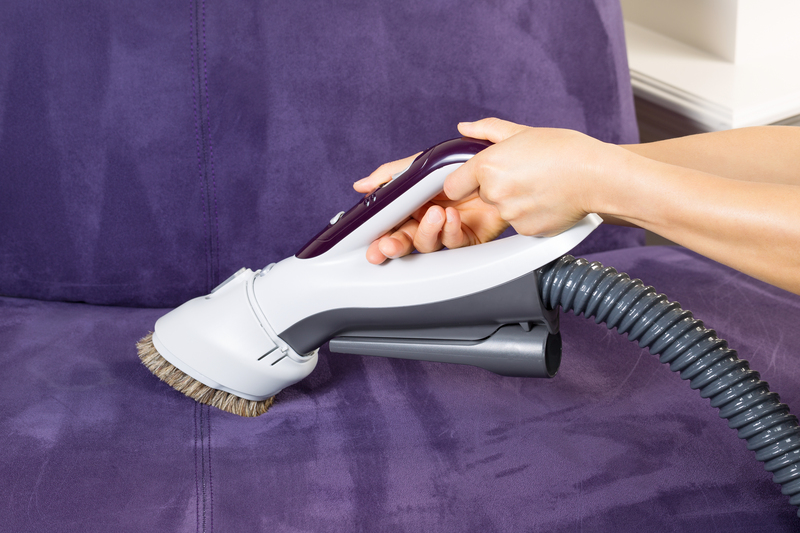Quick and Simple Methods for a Spotless Stovetop Free from Burn Marks
Posted on 24/09/2025
Quick and Simple Methods for a Spotless Stovetop Free from Burn Marks
Keeping your kitchen clean is not only about aesthetics but also about ensuring hygiene and safety. Among all kitchen appliances, the stovetop is arguably the most used and, therefore, the most susceptible to stains and burnt marks. If you are tired of seeing those unsightly blackened circles and streaks, there is good news! This comprehensive guide will reveal quick and simple methods for a spotless stovetop free from burn marks, ensuring your cooking space shines every day.

Why Stovetops Accumulate Burn Marks
Before jumping into effective cleaning solutions, it's essential to understand why burn marks appear and linger on your beloved stovetop:
- Spilled food and oil get heated repeatedly, leaving tough stains.
- Sugar-based residues caramelize, resulting in stubborn burn marks.
- High heat settings cause accidental scorching, discoloration, and marks.
- Lack of timely cleaning leads to hardened, tough-to-remove spots and buildup.
Identifying the cause is the first step in selecting the most effective cleaning approach for a sparkling, mark-free cooktop.
Preparing Your Stovetop and Gathering Supplies
For quick and simple stovetop cleaning, you'll need a few basic supplies:
- Baking soda
- White vinegar
- Lemon
- Dish soap
- Microfiber cloths or sponges
- Soft-bristled brush or toothbrush
- Razor scraper (for glass stovetops)
- Papertowels
- Gloves (optional)
Always ensure the stovetop is switched off and cool to the touch before starting your cleaning process.
Quick and Simple Methods for a Spotless Stovetop
1. Everyday Cleaning for Spotless Results
The key to a clean, burn-mark-free stovetop is consistency. Here's a quick routine you can follow after each cooking session:
- Wipe away any food spills or splatters with a damp microfiber cloth immediately after cooking.
- Mix a small amount of dish soap with warm water, lightly scrub over the entire surface, then dry with a clean towel.
- If you notice minor stains, sprinkle baking soda over them, dampen the area, and let sit for 5 minutes. Wipe clean with a soft cloth.
This routine prevents stains and burn marks from settling, ensuring an immaculate stove surface daily.
2. Baking Soda and Vinegar Method: Natural and Effective
The combination of baking soda and vinegar is a favorite DIY cleaning hack for a spotless stovetop, especially when tackling burn marks:
- Sprinkle a generous layer of baking soda directly onto the stained or burnt areas.
- Spray or drizzle white vinegar over the baking soda. The fizzing reaction helps lift stubborn residue.
- Allow the mixture to sit for about 15 minutes.
- Use a soft sponge or brush to gently scrub the area in a circular motion.
- Wipe away the paste with a damp cloth. Repeat if necessary for heavier spots.
This method is safe for most stovetops, including gas, electric, and glass surfaces.
3. Lemon Power: The Natural Burn Mark Remover
Lemon's acidity makes it a natural degreaser. Here's how you can use it for a pristine cooktop:
- Cut a fresh lemon in half.
- Rub the cut side firmly over burn marks and greasy patches.
- Let the juice sit for a few minutes to break down the grime.
- Wipe away with a damp cloth. For tough stains, sprinkle baking soda first, then rub with lemon.
This technique works wonders for stainless steel and ceramic stove surfaces without leaving scratches.
4. How to Clean Burn Marks from Glass Stove Tops
Glass and ceramic stove tops need gentle handling to avoid scratching. For a spotless glass stovetop free from burn marks:
- Apply a paste made of baking soda and a little water over the burnt spots.
- Cover the area with a warm, damp cloth and let it sit for at least 15 minutes.
- Gently wipe the residue in circular motions.
- For stubborn, stuck-on marks, carefully use a patented razor scraper held at a 45-degree angle. Scrape slowly and gently.
- Wipe again with a clean, damp cloth and dry thoroughly for a streak-free shine.
Always avoid abrasive scrubbers on glass to maintain its flawless finish.
5. Targeting Tough Burn Marks with Commercial Cleaners
For particularly burnt-in marks that natural remedies can't handle, specialized stovetop cleaners are available:
- Choose a product designed specifically for your stovetop type (gas, electric, glass, enamel, or stainless steel).
- Follow the manufacturer's instructions closely. Usually, you'll need to apply the cleaner, let it sit, and then wipe with a non-abrasive cloth.
- Always rinse thoroughly to remove any residue and avoid chemical smells when you next use the stove.
These products are widely available and designed for quick and safe removal of stubborn burn marks without damaging your appliance.
Extra Tips for Keeping Your Stovetop Spotless and Mark-Free
Prevent Burn Marks Before They Happen
- Clean spills as soon as possible. The longer they sit, the tougher they become to remove.
- Always use pots and pans that fit properly on burners to prevent food and liquids from overflowing onto the surface.
- Cook over medium heat where possible, as high heat can scorch the cooktop and leave lasting marks.
- Consider lining gas burner pans with aluminum foil. Only do this if the manufacturer recommends it.
- Regularly inspect burners and drip pans (if applicable), and clean them independently to prevent residue buildup.
Establishing a simple post-dinner cleaning habit can prevent the need for deep cleaning sessions.
Special Care for Different Stovetop Types
- Gas Stoves: Remove grates and soak in hot, soapy water. Scrub with a brush, then dry before buffing the surface.
- Electric Stovetops: Take off burner coils and drip pans. Clean them separately and ensure all parts are dry before reassembly.
- Glass/Ceramic: Use only soft cloths and certified glass cleaner. Scrape carefully if necessary, then polish with a microfiber cloth.
- Induction: Similar to glass tops, avoid abrasives, and use gentle, circular cleaning motions.
Following the recommended care for your specific stovetop extends its life and keeps it looking new.
Avoid These Common Mistakes When Cleaning Burnt Stovetops
- Never use steel wool, scouring pads, or hard-bristled brushes on glass or ceramic tops--they scratch easily.
- Avoid harsh chemicals like oven cleaners unless specified for stove use; they can corrode surfaces and cause discoloration.
- Don't attempt to clean a stovetop before it's cool; this can cause burns and crack glass surfaces due to thermal shock.
- Never use a knife or metal spatula to scrape burn marks--it increases the risk of permanent damage.
Using the right method ensures both effectiveness and safety for your stovetop.
DIY Cleaning Solutions for Fast Burn Mark Removal
Baking Soda Paste
- Mix 3 parts baking soda with 1 part water for a thick, spreadable paste.
- Apply directly onto burnt areas. Let it sit for 15-30 minutes as it draws out stains.
- Wipe clean using a damp cloth for a gleaming cooktop free from burn marks.
Vinegar Spray
- Fill a spray bottle with equal parts white vinegar and water.
- Spray liberally over stains, especially grease marks.
- Let it sit for 5-10 minutes, then scrub with a soft sponge and dry thoroughly.
Lemon and Salt Scrub
- Sprinkle coarse salt over burn marks.
- Scrub gently with half a lemon, squeezing lightly to release juice.
- The natural abrasiveness of salt and lemon's acidity lifts away stubborn grime and leaves a fresh scent.
When to Deep Clean Your Stovetop
For a truly spotless stovetop free from burn marks, consider a deeper clean:
- Once a week, especially if you do heavy cooking and encounter frequent spills.
- After any big event or cooking session that resulted in overflow, burns, or stuck-on food.
- If you notice discoloration or areas that feel sticky even after routine cleaning.
Taking the time to deep clean periodically prevents permanent staining and maintains both appearance and function.

Professional Help: When to Call the Experts
Sometimes, no matter how hard you scrub, years of neglect or a particularly nasty burn require professional attention. Consider seeking help if:
- The burn marks have permanently discolored the surface despite all efforts.
- You notice cracks, chipping, or other damage due to misguided cleaning attempts.
- There is a persistent chemical odor or residue after DIY cleaning, especially on glass or induction models.
Professional appliance cleaning services have specialized products and tools that can restore most cooktops safely.
Conclusion: Maintaining a Spotless, Burn Mark-Free Stovetop
Achieving and maintaining a spotless stovetop free from burn marks is entirely possible with the right techniques and a little consistency. Whether your stove is glass, stainless steel, ceramic, or induction, the methods outlined above are quick, chemical-free, and highly effective. Incorporate these habits into your daily kitchen routine, and you'll be rewarded with a beautiful, gleaming cooktop that makes cooking a joy.
Remember: Timely action, gentle cleaning, and the use of safe products are the secrets to protecting your investment and enjoying a spotless, hygienic, and burn mark-free stovetop for years to come.
- Adopt daily quick cleaning habits.
- Use natural ingredients for safe and effective stain removal.
- Handle different stovetop types with care.
- Act quickly to prevent burn marks from becoming permanent stains.
With these quick and simple methods, your stovetop will always be ready to impress!




